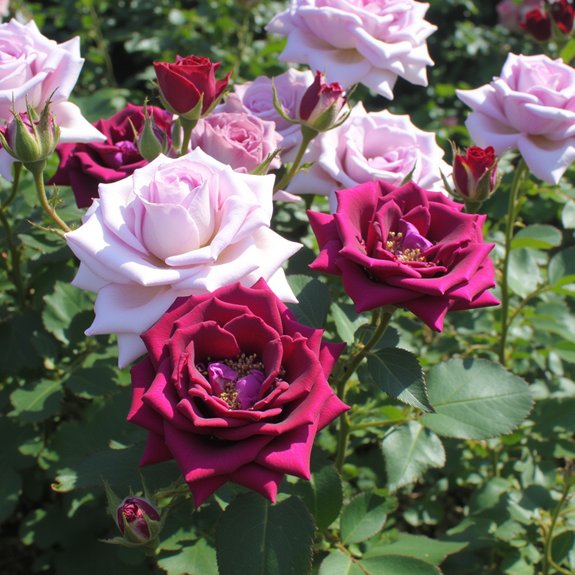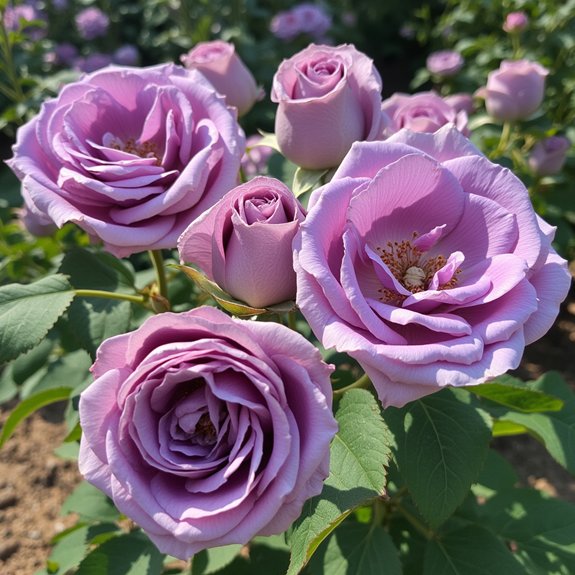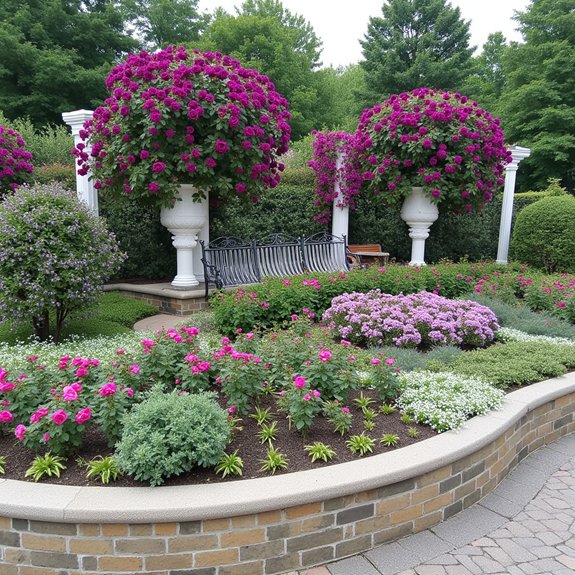Purple and lilac roses captivate gardeners with their distinctive hues, ranging from soft lavender tones to deep violet shades. These cultivars, developed through decades of careful breeding, offer fragrance profiles that span from citrusy bergamot notes to traditional damask scents. Most varieties reach 3-5 feet in height, requiring 6-8 hours of morning sunlight and well-draining soil with pH levels between 6.0-7.0. However, selecting the right cultivar for specific growing conditions requires understanding their unique characteristics.
Contents
- 1 The Allure of Purple and Lilac Rose Varieties
- 2 Top Purple Rose Cultivars for Your Garden
- 3 Fragrance Profiles of Lavender-Hued Roses
- 4 Growing Requirements and Care Tips
- 5 Design Ideas for Purple Rose Garden Displays
- 6 Seasonal Blooming Patterns and Maintenance
- 7 Companion Plants That Complement Purple Roses
The Allure of Purple and Lilac Rose Varieties

While traditional red and pink roses dominate most gardens, purple and lilac varieties offer an enchanting alternative that transforms ordinary landscapes into extraordinary displays. These unique cultivars carry deep color symbolism, representing mystery, enchantment, and first love in floral traditions. Their historical significance dates back centuries, with European nobility prizing rare purple blooms as symbols of luxury and sophistication.
Modern breeding techniques have expanded purple rose options dramatically. Gardeners can now choose from compact 2-foot varieties to towering 7-foot climbers, each offering distinct fragrance profiles from citrus-spice to old rose perfume, creating mesmerizing focal points in any landscape design.
Top Purple Rose Cultivars for Your Garden
Several exceptional purple and lilac rose varieties stand out for their reliability, beauty, and garden performance. Reine des Violettes offers historical significance as a classic Old Garden Rose, featuring lilac-pink quartered blooms and thornless canes reaching 3-4 feet. Plum Perfect delivers unique colorations with violet plum petals fading to lavender, plus excellent black spot resistance in compact 3-4 foot plants. Easy on the Eyes presents orchid purple with deep centers, ideal for beginners at 2-3 feet tall. Purple Tiger showcases distinctive dark violet and raspberry stripes on white backgrounds, blooming repeatedly through frost seasons.
Fragrance Profiles of Lavender-Hued Roses

Beyond their stunning visual appeal, purple and lilac roses deliver an extraordinary range of fragrance profiles that can transform any garden into an aromatic paradise. Fragrance intensity varies dramatically among cultivars, from Blue Moon’s sharp grapefruit notes to Purple Tiger’s classic old rose perfume. Gardeners with citrus scent preferences will gravitate toward Easy on the Eyes, which combines citrus and spice beautifully. Meanwhile, those favoring sweet aromas should consider Blue for You’s candied apple and clove combination. Reine des Violettes offers a distinctive peppery fragrance, while Quicksilver provides mild fruity notes for subtle appeal.
Growing Requirements and Care Tips
Most purple and lilac roses thrive in identical growing conditions, requiring full sun exposure for at least six hours daily to produce their most vibrant blooms. Well-draining soil types work best, particularly loamy mixtures with pH levels between 6.0-7.0. Clay soils need amendments like compost or perlite to prevent waterlogged roots.
Proper watering practices involve deep, infrequent sessions rather than daily sprinkles. Water at soil level, avoiding wet foliage that encourages disease. During growing season, provide one inch weekly through soaker hoses or drip irrigation. Morning watering allows leaves to dry completely before evening, reducing fungal problems considerably.
Design Ideas for Purple Rose Garden Displays

When planning purple rose garden displays, gardeners can create stunning visual impact through strategic color combinations and thoughtful placement. Design inspirations include pairing compact varieties like Easy on the Eyes (2-3 feet) with taller Quicksilver climbers (5-7 feet) for layered depth. White or cream companions enhance purple blooms beautifully, while silver foliage plants complement mauve tones perfectly. Consider clustering three to five plants of the same variety for maximum color impact. Mass plantings of Lavender Dream or Twilight Zone create dramatic focal points in borders. These thoughtful color combinations transform ordinary gardens into spectacular purple showcases.
Seasonal Blooming Patterns and Maintenance
Understanding blooming cycles helps gardeners maximize the beauty of purple and lilac roses throughout the growing season. Most purple varieties like Purple Tiger bloom repeatedly from spring through frost, providing continuous color for six months. Peak flowering occurs in late spring and early fall when temperatures remain between 60-75°F.
Seasonal care varies greatly throughout the year. Spring requires pruning dead canes and applying balanced fertilizer. Summer demands weekly watering, delivering 1-2 inches deep at soil level. Fall preparation includes reducing watering frequency and avoiding late-season fertilizing. Winter protection involves mulching around base stems with 3-4 inches of organic material in zones 5-6.
Companion Plants That Complement Purple Roses
Beyond proper seasonal care, successful purple rose gardens depend heavily on thoughtful companion plantings that enhance both color harmony and growing conditions. Strategic color combinations create stunning visual impact when pairing purple roses with silver-leafed plants like artemisia or lamb’s ear. These plant pairings provide complementary textures while highlighting the roses’ rich hues. White flowering perennials, including phlox and delphiniums, create elegant contrasts that make purple blooms pop. Yellow companions like coreopsis or black-eyed Susans establish vibrant opposition. Consider lavender, catmint, or salvia for aromatic borders that share similar growing requirements and bloom times with purple rose varieties.
